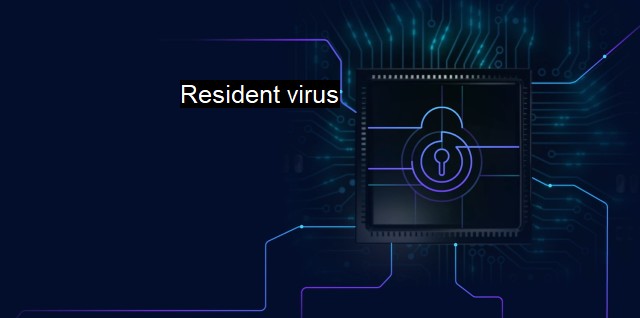What are Resident virus?
Unleashing the Challenge: Addressing Resident Viruses in Cybersecurity and Antivirus Technology
A "resident virus" is one of the most common categories of malicious software, commonly known as malware, that typically functions by taking up permanent residence in a computer's memory. Much like biological viruses begin functioning immediately upon entering a host, so do these cyber threats begin their operations within a computer system upon intrusion. Similar to biological viruses that are broadcasted via interaction or contact, resident viruses spread their destructive codes when other programs interact with the altered section of memory that contains the resident virus.The defining characteristic that differentiates resident viruses from other types of computer malware is their stealthy method of deployment. Unlike non-resident viruses that initiate their deleterious maneuvers immediately upon being run, resident viruses linger in a computer’s RAM during its lifecycle, predisposed to intercept other software operations, hence interposing and disturbing the normal computational functionality. An essential attribute of the primary functionality of the resident virus is its replicative nature, as it can reproduce numerous copies of itself, infecting other components of the operating system.
Resident virus typically enters a computer system by means of code execution that incorporates an installation module. This installation module sets the groundwork for the deployment of the replication module, which dictates the reproduction and continuance of the virus within the system. unlike simpler forms of viruses, the decision to duplicate isn't imposed during every operation run. Instead, resident viruses employ a unique extract of conditional flow, deciding when to reproduce based on certain conditions. This strategic operation mechanism extends the longevity of the virus within the system, significantly jeopardizing cybersecurity, well before most would even perceive the threat.
Resident viruses are rightfully considered formidable threats to cybersecurity as their concealed existence often slips past system checks, multiple standard security measures, and even antivirus software. It's important to mention though that not every antivirus software is vulnerable to resident viruses. An asset to note about antivirus software that renders them potential eliminators of these viruses is their use of separate memory spaces to prevent hostile tampering during code execution. Therefore, antivirus software often capable of combatting these stealthy predators is integrated with functionality recognizing suspicious activity patterns beside offering full system scans.
Resident viruses are more resistant than non-resident viruses and can easily relaunch after each startup, allowing them to control certain operations while many antiviruses cannot reach their location due to limited scanning capabilities. These unique capabilities allow them to engage in a variety of destructive behaviors, including data corruption, unauthorized access to sensitive data, and other forms of digital espionage, thereby posing significant risks to corporate, government, or personal data.
It becomes evident that resident viruses represent substantial challenges within cybersecurity. The clandestine nature of their propagation, coupled with their ability to slip past numerous security measures, ensures a long-standing presence within systems, allowing for sinister operations such as data theft and interference with normal computer processing.
Consequently, mitigating the devastating effects of resident viruses requires taking extra measures, over and beyond the use of generalized antiviruses. These protective strategies entail redefining security policies, implementing more vigorous encryption systems, regular auditing and alteration of access permissions, detailed inspection of system behavioural patterns, and proper education about recognition of lurking harmful elements like phishing attempts or corrupted files.
While the exponential progress in technology has put awe-inspiring tools and resources at users' disposal, it has concurrently nurtured insecurities within the landscape of cybersecurity. Resident viruses are a prime example of these insecurities, validating the need for relentless advancements in cybersecurity measures to not only counteract but prevent intrusive elements from breaching system boundaries. The threat of these stealthy assailants highlights the significance of constant vigilance, responsible digital behavior, and a sound cybersecurity strategy.

Resident virus FAQs
What is a resident virus in cybersecurity?
A resident virus is a type of computer virus that hides in the computer's memory, making it difficult to detect and remove. It stays active in the computer even after the infected program has been closed, and it can infect other programs and files as they are opened.How does a resident virus differ from other types of viruses?
Unlike other viruses that infect files or programs and become inactive until the infected file or program is opened, a resident virus stays active in the computer's memory all the time, making it difficult to detect and remove.What are the common symptoms of a resident virus infection?
The common symptoms of a resident virus infection include slow performance of the computer, frequent crashes, and unusual error messages. The infected computer may also have difficulty running certain programs or accessing certain files.How can you protect your computer from resident viruses?
You can protect your computer from resident viruses by installing reputable antivirus software and keeping it up-to-date. Use a strong and unique password for your accounts and avoid opening attachments or clicking on links from unknown or suspicious sources. Regularly scan your computer for viruses and malware, and keep your operating system and software updated with the latest security patches.| | A | | | B | | | C | | | D | | | E | | | F | | | G | | | H | | | I | | | J | | | K | | | L | | | M | |
| | N | | | O | | | P | | | Q | | | R | | | S | | | T | | | U | | | V | | | W | | | X | | | Y | | | Z | |
| | 1 | | | 2 | | | 3 | | | 4 | | | 7 | | | 8 | | |||||||